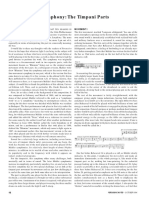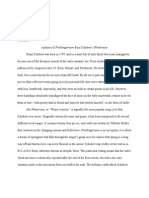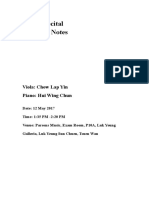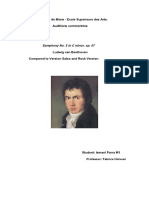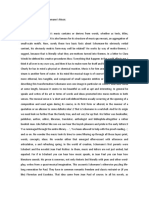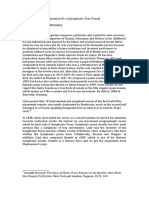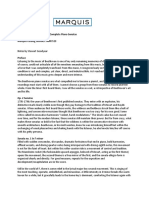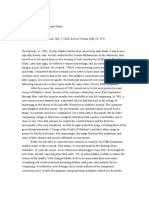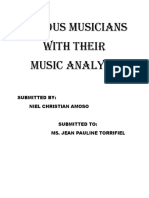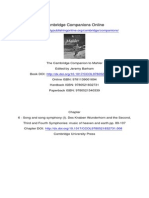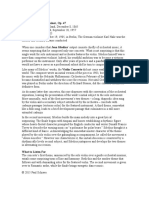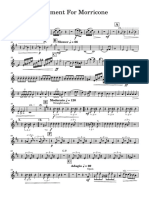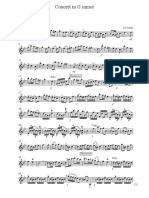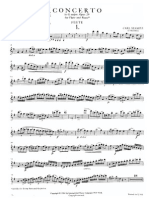ProQuestDocuments 2022 04 25
ProQuestDocuments 2022 04 25
Uploaded by
coolonesyok8Copyright:
Available Formats
ProQuestDocuments 2022 04 25
ProQuestDocuments 2022 04 25
Uploaded by
coolonesyok8Original Title
Copyright
Available Formats
Share this document
Did you find this document useful?
Is this content inappropriate?
Copyright:
Available Formats
ProQuestDocuments 2022 04 25
ProQuestDocuments 2022 04 25
Uploaded by
coolonesyok8Copyright:
Available Formats
Gustav Mahler's Symphony No.
9
Chenoweth, Richard . The Horn Call : Journal of the International Horn Society; Durant Vol. 39, Iss. 3,
(May 2009): 63-65.
ProQuest 文档链接
An Interview with Elizabeth Freimuth
Few composers are more highly regarded by horn players than Gustav Mahler (1860-1911). Mahler's symphonies
contain brilliant, soloistic, expressive, and heroic horn passages that emphasize the broad tonal and emotional
range of the instrument. In addition, most of his symphonies employ more than four horns, thus providing addition
performance opportunities for area hornists when one of his symphonies appears on an orchestra's concert series.
Only Symphonies No. 4 and 9 are scored for four horns - all of the others employ extra players. Although Mahler
began work on a Tenth Symphony, it was never completed. When this Symphony is programmed, it is usually
performed in a version realized by Deryck Cooke, which has four horn parts.
Mahler's Symphony No. 9, written between 1909 and 1911, remains one of his most discussed and popular
symphonic works. Sometimes referred to as his "Farewell" symphony, Mahler wrote the 9th while already aware of
his own fatal heart ailment. Some sources believe that the first-movement quotation from Beethoven's Op. 81a
Piano Sonata (Les adieux) also contributes to that subtitle. Tragically, Mahler never heard a performance of his 9th
Symphony, the premiere of which was given in Vienna in 1912 with Bruno Walter conducting.
Although labeled as a symphony, it does not follow the conventional form of the Classical/Romantic symphony.
The outer movements are slow, while the middle two movements are faster. The first movement begins Andante
comodo, with a motive that has been variously described the "voice of fate" or, as Leonard Bernstein espoused in
his Norton Lectures at Harvard, a reflection of Mahler's own irregular heart-beat. The second movement (Im Tempo
eines gemächlichen Ländler - in the tempo of a moderate Ländler) is a parody of that Austrian dance form with
variations. Movement III (Rondo. Burleske Allegro assai, Sehr trotzig - Rondo. Burlesque Allegro assai, very defiant)
is a massive movement that contains dissonant harmonies and complicated fugal writing more appropriate for a
final movement. The last movement (Adagio. Sehr langsam und noch zurückhaltend - very slow and holding back
even more) is an expressive song for orchestra which ends with fragments of the principal melody from the first
movement. It has been characterized as a resolution between Mahler's thoughts of his impending death and his
affirmation of life.
In a recent interview, Elizabeth Freimuth, principal horn of the Cincinnati Symphony, shared her thoughts and
suggestions regarding the performance of the first horn part of Mahler's 9th Symphony:
Elizabeth Freimuth: It is very important to consider the context of the piece before playing it - too many young
players focus on the trees rather than the forest, meaning that they worry about the technical issues of the piece
rather than the musical and emotional content found in the symphony. The work begins with musical "sighs,"
setting up the melancholic nature of the first movement.
Mahler was superstitious about writing a 9th Symphony, as symphonies given the number nine had been the last
symphonies of Beethoven and Bruckner. Mahler tried to trick the "Ninth-Symphony-Counting-Gods" by writing the
symphonic-length Das Lied von der Erde, but found that he was already stricken with a fatal heart ailment. Thus, a
fear of death and a type of irrationality is reflected throughout the 9th Symphony, although the last movement
contains a feeling of acceptance and resolution.
Playing this piece goes far beyond the practice room - if you try to approach this as a traditional symphony, such
PROQUEST.COM PDF Page 1 of 4
as a one by Brahms that contains several big solos but also periods of rest, you will be missing something. This
work is complicated and emotional because Mahler was placing the reality of his own impending death into the
music. From the moment that you start playing to the finish, you are in a marathon - there is no marking time or
letting up. Every note is crucial to the emotional moods of the piece, so physical exhaustion is a given and,
mentally, you're squeezed dry. It requires such intense mental commitment that, if you are not exhausted at the
end, you probably have not taken the journey.
Movement I contains the most-commonly requested excerpt from this symphony for orchestral auditions:
This excerpt includes a wide emotional spectrum. This is an important solo that is played simultaneously with a
contrasting flute. Although it is important to match and line up rhythms with the flute, these are solos of parallel
emotional extremes. The flute seems to be portraying an almost giddy joy on the verge of madness, while the horn
alternates between joy and despair. It is a complicated passage to organize but in performance often seems to
sort itself out. The mood that underlies this entire solo contains an intensity that seems to imply, "I think I'm losing
my mind."
Beginning with a dance-like and easy-going motive, the mood changes abruptly as the triplets become more
chromatic in mm. 384-385, becoming more manic and intense as the rhythm changes to the sixteenth-notes. The
tempo is sometimes pushed here (mms. 385-386) or at least an increase of intensity should give the impression of
moving forward and the crescendo at this point should be exaggerated, until the abrupt mood change at the subito
piano. At this point, the mood reverts to the easy-going style. Exaggerating the articulation here adds flavor and
characterizes the "bi-polar" mood swings. What does this trill mean? Play it with a carefree style, then the final
crescendo with the chromatic passage is a snap back into reality. Suggested breathing points in the solo are
marked above with a V.
Movement I also contains one of the most beautiful lyrical moments in the entire symphony:
This is such a beautiful moment, loving and tender. In playing this solo, be beyond the horn, with an absolutely
vocal inflection. This is also about what you do between the notes. It is significant that there are hardly any
dynamic markings, other than the first diminuendo, with minimal instructions (zart gesungen, aber sehr
hervortretend - gently cantabile, but very expressive). This solo is all about the "sigh" and farewell, so it is important
to recognize and portray the implied personal expression and not think hornistically
Another beautiful moment is the final solo passage at the end of the first movement:
In a way, this is reminiscent of the earlier material in Ex. 2, with a similar theme of longing. After the descending
"sighing" theme, the chromaticism reappears, underscoring the intensity and ambiguous emotional state. Be sure
to not play so softly in the final chromatic passage that the movement between the notes is not apparent.
However, the final 4 notes, with their major modality, reflect acceptance and calm.
The first movement is like an entire symphony - a mini version of the entire piece. If you are asked to play this on
an audition, think of it as an opportunity to play music, not as a test.
The second movement contains lots of trills - it requires great flexibility and a different set of skills than the first
movement. Keep the style fresh, masculine, and youthful. This movement is reminiscent of a specific earlier time
in Mahler's life, so the style should be energetic and vibrant. In general, keep the trills light.
The third movement has lots of tutti material. The title Burlesque is exemplified by passages such as this:
In this case, the trill should be more like a "shake" - the sound should "rattle" and be quite noisy. Accent the grace
notes and exaggerate all of the ornamentation.
In a later passage, there is a very organized trill:
It might be safer to play mms. 266-267 with your valves, rather than as slow controlled trills, since this passage is
doubled with the third horn and in the woodwinds. In any case, the sixteenths should be very even and clean.
Movement IV has moments of great emotional content, a relinquishing of the struggle. In this example, Mahler
seems to be portraying a soul ascending:
This movement is very tonal and optimistic, as if Mahler's writing is telling us that the struggle is over. This
affirmation is apparent in that the convoluted chromaticism of previous movements is now gone, and the melodies
PROQUEST.COM PDF Page 2 of 4
are broad and noble.
Pick moments that acknowledge the moods and motives, and think about your playing in an emotional and
musical style, while not getting caught up in the technicalities of the piece. Think about what you do, not about
what you don't do. Imagine the possibilities and allow them to happen. Mahler was very successful in telling a
story in sound - he used a "kitchen German" to give very specific instructions about how he wanted the music to
sound. This symphony tells about his life, as if he is speaking to us from the grave.
Elizabeth Freimuth is the principal horn of the Cincinnati Symphony and Pops Orchestras. Before joining the CSO
in 2006 she was principal horn of the San Francisco Ballet Orchestra (2005-2006), principal horn of the Kansas City
Symphony (2000-2005), and assistant principal horn of the Colorado Symphony (1998-2000). She was the adjunct
professor of horn at the University of Missouri-Kansas City Conservatory of Music 2000-2003. In summers,
Elizabeth performs with the Sun Valley Summer Symphony and the Grand Teton Music Festival. She has been a
member of the Chamber Music Society of Kansas City, the principal horn of the Kansas City Chamber Orchestra,
and has performed with the Burning River Brass.
AuthorAffiliation
by Richard Chenoweth, Series Editor
AuthorAffiliation
Richard Chenoweth is professor of horn at the University of Dayton and principal horn of the Dayton Philharmonic
Orchestra. He has performed as second horn with the Santa Fe Opera for thirty-five years and is a founding
member of the Carillon Brass Quintet. Richard has made numerous recordings for the MMC, Integra, and
Equilibrium labels and his newest recording, The Horn in Opera, is available at: thehorninopera.com.
The Mahler 9th Symphony excerpts were realized for this article using Finale 2007 by hornist Eric Fehrman, a
member of the University of Dayton horn studio.
: Gustav Mahler's Symphony No. 9
: Chenoweth, Richard
: The Horn Call:; Journal of the International Horn Society; Durant
: 39
: 3
: 63-65
: 3
: 2009
: May 2009
: International Horn Society
: Durant
/: United States, Durant
PROQUEST.COM PDF Page 3 of 4
: Music
ISSN: 00467928
: English
: Ge neral Information
ProQuest ID: 224160257
URL: https://www.proquest.com/trade-journals/gustav-mahlers-symphony-no-
9/docview/224160257/se-2?accountid=10253
: Copyright International Horn Society May 2009
: 2010-06-09
: Music Periodicals Database
2022 ProQuest LLC
条款与条件 联系 ProQuest
PROQUEST.COM PDF Page 4 of 4
You might also like
- Sinfonía Nº1 MahlerDocument8 pagesSinfonía Nº1 MahlerPepeNo ratings yet
- About Schumann Symphony No 2Document3 pagesAbout Schumann Symphony No 2karayevNo ratings yet
- Program Notes: Gustav MahlerDocument3 pagesProgram Notes: Gustav MahlerPavol GyuríkNo ratings yet
- Listening Journal: Ashley Black CannovaDocument14 pagesListening Journal: Ashley Black CannovaAshley BlackNo ratings yet
- Mahler 5Document3 pagesMahler 5Amanda HarrisNo ratings yet
- Mahler 2Document32 pagesMahler 2sporktorkNo ratings yet
- The World of The String Quartet: 3. The Humanists: Schubert, Mendelssohn, Schumann, and BrahmsDocument19 pagesThe World of The String Quartet: 3. The Humanists: Schubert, Mendelssohn, Schumann, and BrahmsSeeTohKevinNo ratings yet
- Jorge-Ojeda-Munoz-Final-Paper RevisedDocument8 pagesJorge-Ojeda-Munoz-Final-Paper RevisedJörge Daviid ÖjedaNo ratings yet
- Mahler VoicesDocument376 pagesMahler Voiceskonst669100% (6)
- Francis Poulenc, Flute Sonata, 1st MVT - Interpretative ChoicesDocument11 pagesFrancis Poulenc, Flute Sonata, 1st MVT - Interpretative ChoicesrahelNo ratings yet
- An Analysis of Gustav Mahler's Symphony No. 2 in C MinorDocument5 pagesAn Analysis of Gustav Mahler's Symphony No. 2 in C MinorLorely FieldsNo ratings yet
- Gustav Mahler - Symphony No. 5 - in The Fourth MovementDocument2 pagesGustav Mahler - Symphony No. 5 - in The Fourth MovementJason TiongcoNo ratings yet
- MAPEH Music & Arts Q2Document5 pagesMAPEH Music & Arts Q2Albert P. LagundayNo ratings yet
- Some Reflections On Mahlers Symphony No. 5Document8 pagesSome Reflections On Mahlers Symphony No. 5Michael WNo ratings yet
- Analysis of FrhlingstraumDocument7 pagesAnalysis of Frhlingstraumapi-270246827No ratings yet
- Mahler 4 PDFDocument7 pagesMahler 4 PDFFrancisco Varela100% (1)
- LTCL Viola Program NotesDocument5 pagesLTCL Viola Program NotesFrank ChowNo ratings yet
- Documento 2 (1) .Es - AsdDocument10 pagesDocumento 2 (1) .Es - AsdIsmael ParraNo ratings yet
- Topical Analysis: Schubert's Winterreise "Der Lindenbaum" & "Wasserfluth"Document6 pagesTopical Analysis: Schubert's Winterreise "Der Lindenbaum" & "Wasserfluth"suriyaprakashNo ratings yet
- Mahler 3 PDFDocument43 pagesMahler 3 PDFblobfinkelsteinNo ratings yet
- Mahler - Final Style AnaylsisDocument8 pagesMahler - Final Style Anaylsisapi-303085301No ratings yet
- Carnaval, Op.9, Is A Solo Piano Work Composed by Robert Schumann During 1834-1835Document17 pagesCarnaval, Op.9, Is A Solo Piano Work Composed by Robert Schumann During 1834-1835Alex YuwenNo ratings yet
- Bernstein Second Symphony (Two Pianos Version)Document97 pagesBernstein Second Symphony (Two Pianos Version)liebenstock96100% (2)
- Université de Montréal Faculté de Musique: Program Notes Final Master RecitalDocument5 pagesUniversité de Montréal Faculté de Musique: Program Notes Final Master RecitalDao PhamNo ratings yet
- Schumann ManferdDocument2 pagesSchumann ManferdJoseph MetrzNo ratings yet
- Revised EssayDocument11 pagesRevised EssaybronteldNo ratings yet
- The Tonal Analogue in Schumann's MusicDocument11 pagesThe Tonal Analogue in Schumann's MusicKleberson CalancaNo ratings yet
- 2011 Choral Demo Jenks For LoveDocument6 pages2011 Choral Demo Jenks For LoveRaymond LullyNo ratings yet
- Les PreludeDocument5 pagesLes PreludeGoh Jun HuiNo ratings yet
- Programs 19671001aDocument4 pagesPrograms 19671001aOrquesta Sinfónica Juvenil UNABNo ratings yet
- Mahler's 2nd Symphony - About PDFDocument6 pagesMahler's 2nd Symphony - About PDFKate SamuelNo ratings yet
- CLASSICAL PERIOD - Genres (Vocal+ Instrumental)Document6 pagesCLASSICAL PERIOD - Genres (Vocal+ Instrumental)AsinashleyNo ratings yet
- Cue Up 7:40-7:50 of Rhenish/Bernstein RecordingDocument4 pagesCue Up 7:40-7:50 of Rhenish/Bernstein RecordingStefano FlavoniNo ratings yet
- Programme NotesDocument9 pagesProgramme NotesAnonymous ZsIPcnb5roNo ratings yet
- Schubert ZimermanDocument5 pagesSchubert ZimermanThierry MoriceNo ratings yet
- Schubert Winterreise 22der Leiermann 22-2Document5 pagesSchubert Winterreise 22der Leiermann 22-2api-454899087100% (1)
- Symbolism in The MusicDocument5 pagesSymbolism in The Musichungary.mn7No ratings yet
- Laudate DominumDocument6 pagesLaudate DominumLisa SteinerNo ratings yet
- W A Mozart Serenade No. 13 PDFDocument3 pagesW A Mozart Serenade No. 13 PDFAlliana HaneNo ratings yet
- Beethoven Sonatas Guide PDFDocument21 pagesBeethoven Sonatas Guide PDFEmmaNo ratings yet
- Oculus Non Vidit: Rhythm and AccentDocument9 pagesOculus Non Vidit: Rhythm and AccentFrancesco Russo100% (2)
- Brahms Alto RhapsodyDocument6 pagesBrahms Alto RhapsodyAine Mulvey100% (1)
- Mozarts Musical LanguageDocument4 pagesMozarts Musical LanguageLiana NegreirosNo ratings yet
- Bedell On Mahler Symphony No 5Document3 pagesBedell On Mahler Symphony No 5Jason McCoolNo ratings yet
- Fantaisie Impromptu: by Fryderyk ChopinDocument13 pagesFantaisie Impromptu: by Fryderyk ChopinKatie FryeNo ratings yet
- Comparison Study BeethovenDocument5 pagesComparison Study BeethovenArturNo ratings yet
- Famous Musicians With Their Music Analysis: Submitted By: Niel Christian AmosoDocument6 pagesFamous Musicians With Their Music Analysis: Submitted By: Niel Christian AmosoLein LychanNo ratings yet
- Robert Schumann: Eriikka Maalismaa The Violin SonatasDocument20 pagesRobert Schumann: Eriikka Maalismaa The Violin SonatasMarco Antônio RibasNo ratings yet
- MotifDocument1 pageMotifswd5h6c57yNo ratings yet
- Program Notes: Gustav MahlerDocument3 pagesProgram Notes: Gustav MahlerTeravut SuwansawaipholNo ratings yet
- Music 120 ElementsDocument3 pagesMusic 120 Elementsapi-317906943No ratings yet
- The Cambridge Companion To Mahler - 6 - Song and Song-SymphonyDocument20 pagesThe Cambridge Companion To Mahler - 6 - Song and Song-SymphonySimon HuntNo ratings yet
- Johannes BrahmsDocument3 pagesJohannes Brahmsjomar artetaNo ratings yet
- Brahms IntermezzoDocument5 pagesBrahms IntermezzoAndrew NgNo ratings yet
- Assignment 8 Music History IIDocument2 pagesAssignment 8 Music History IIJay ShankarNo ratings yet
- Music 518 Unit Study The Witch and The SaintDocument6 pagesMusic 518 Unit Study The Witch and The Saintapi-423095618No ratings yet
- (Escreva o Título Do Documento) CD1: Haydn 1Document4 pages(Escreva o Título Do Documento) CD1: Haydn 1Luis RamalhoNo ratings yet
- Orchestral Excerpts 1 Volume PDFDocument63 pagesOrchestral Excerpts 1 Volume PDFcamilo148100% (1)
- Orchestral Excerpts 3 VolumeDocument62 pagesOrchestral Excerpts 3 Volumecepi llos100% (2)
- 1 931706940195860-1 PDFDocument10 pages1 931706940195860-1 PDF清水佑一No ratings yet
- Lexcerpts - Orchestral Excerpts For Clarinet v3.1 (US) PDFDocument49 pagesLexcerpts - Orchestral Excerpts For Clarinet v3.1 (US) PDFGuilhermeson Clarinetista100% (2)
- Jean Sibelius Violin Concerto in D Minor, Op. 47Document1 pageJean Sibelius Violin Concerto in D Minor, Op. 47JenniferNo ratings yet
- Bach Concerto in A Minor Violin 1Document8 pagesBach Concerto in A Minor Violin 1Consuelo Froehner100% (1)
- Moment For Morricone: Trumpet in BB 2Document3 pagesMoment For Morricone: Trumpet in BB 2Manel ArocasNo ratings yet
- Richard Strauss Measure Instruments Source: Ein HeldenlebenDocument3 pagesRichard Strauss Measure Instruments Source: Ein Heldenleben辛克元100% (1)
- Philorch Second Trombone Repertoire Sept 2024 v1Document2 pagesPhilorch Second Trombone Repertoire Sept 2024 v1Zach IrwinNo ratings yet
- Vivaldi Violin Concerto in G Minor RV 317 Violin Score PDFDocument3 pagesVivaldi Violin Concerto in G Minor RV 317 Violin Score PDFLuis Felipe Osorio Jimenez100% (1)
- Vivaldi - Violin Concerto in G Major Op. 7 No. 2Document4 pagesVivaldi - Violin Concerto in G Major Op. 7 No. 2Kostadinka Oncheva0% (1)
- No 13 - Oboe 1 GiselleDocument1 pageNo 13 - Oboe 1 GiselleMiklós KovácsNo ratings yet
- Violin2-Summer Presto VivaldiDocument4 pagesViolin2-Summer Presto VivaldiAydın YavaşNo ratings yet
- Violin Concerto No. 1 in B-Flat Major, K. 207Document6 pagesViolin Concerto No. 1 in B-Flat Major, K. 207marta0% (1)
- Brandenburg Concerto 1 1 First Movement Score and PartsDocument20 pagesBrandenburg Concerto 1 1 First Movement Score and PartsKemal BiserNo ratings yet
- Rachmaninov - Piano Concerto No 3 (Full Score), I 1Document11 pagesRachmaninov - Piano Concerto No 3 (Full Score), I 1api-376430680% (5)
- Stamitz - Flute Concerto in GDocument8 pagesStamitz - Flute Concerto in GArtem Motovilov50% (2)
- Sixieme Solo de Concert For Tenor SaxophoneDocument1 pageSixieme Solo de Concert For Tenor SaxophoneAgustín Paredes PuertoNo ratings yet
- L'Inverno Winter 1st Movement - VivaldiDocument50 pagesL'Inverno Winter 1st Movement - VivaldiCarlNo ratings yet
- IMSLP558076-PMLP4595-Mozart-Horn Concerto K495-Horn in Fa PDFDocument5 pagesIMSLP558076-PMLP4595-Mozart-Horn Concerto K495-Horn in Fa PDFMatheus BarcielaNo ratings yet
- ProgramNotes Schubert Symphony3Document2 pagesProgramNotes Schubert Symphony3Grelus RaduNo ratings yet
- Beethoven: Selected Works Transcribed For GuitarDocument6 pagesBeethoven: Selected Works Transcribed For GuitarIgnacio Pérez-VictoriaNo ratings yet
- ELGAR Pomp & Circumstance n.1 - LemareDocument16 pagesELGAR Pomp & Circumstance n.1 - LemareppiccoliniNo ratings yet
- Vivaldi Concerto RV 430 FlautoDocument5 pagesVivaldi Concerto RV 430 FlautoAntonio VivaldiNo ratings yet
- Chanson de Matin by Elgar For Piano Solo - PREVIEWDocument4 pagesChanson de Matin by Elgar For Piano Solo - PREVIEWKlas KrantzNo ratings yet
- Chaconne in A MinorDocument24 pagesChaconne in A Minorapi-665094320No ratings yet
- Part Pauer BassoonDocument8 pagesPart Pauer BassoonGigi DudaNo ratings yet
- Santoro - Fantasia Sul América (Grade)Document13 pagesSantoro - Fantasia Sul América (Grade)Thiago de FreitasNo ratings yet
- IMSLP29899-PMLP59201-Vivaldi Concerto - In.d.minor - Rb535.for.2.oboes - Strings.and - BC.van Wassenaerconsort Original Hb1Document5 pagesIMSLP29899-PMLP59201-Vivaldi Concerto - In.d.minor - Rb535.for.2.oboes - Strings.and - BC.van Wassenaerconsort Original Hb1Luis Fernando Aldana RojasNo ratings yet
